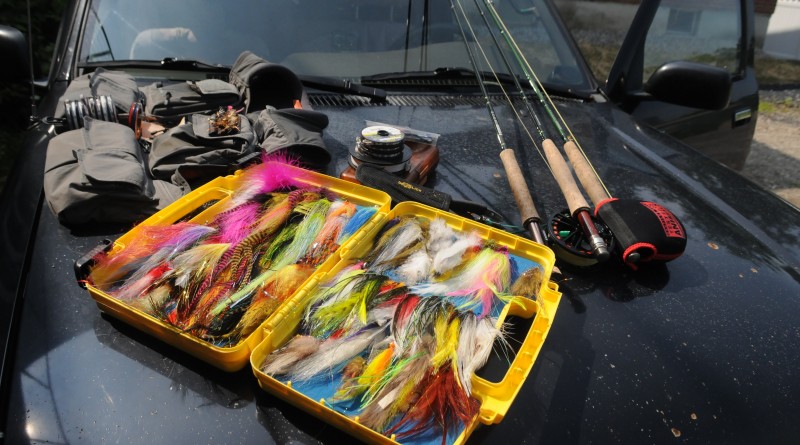Your fly fishing gear guide
Imagine this scenario:
On the eve of your annual Vermont fishing trip, your bags are brimming with the latest and greatest in angling technology. Over the past few months, you’ve contacted all the local fly shops at your destination for advice, in the process becoming an amateur entomologist, fisheries technician, and deranged nature poet all in one.
You get into internet bidding wars with adolescent girls over hackle feathers that you used to tie flies with before they became coveted hair accessories. You’re the only guy at work who knows what a ‘bobbin’ is.
Then, just as your meticulously laid plains are set to come into fruition, the unthinkable happens: your flight into Burlington International is diverted by inclement weather, resulting in a crash landing in a remote dairy field. When the smoke clears, your gear, strewn about the disaster site, is damaged beyond repair—to say nothing of a few unlucky bovines.
Like any true angler, you refuse to be stopped by mere unforeseen weather events, and, squaring your shoulders, you start off toward the nearest town, expecting a hatch at sunrise.
You arrive in town hours later disheveled and dust-covered, muttering to yourself about fluorocarbon. But you’re in luck—the fly shop is open for another half hour.
What essentials do you buy for tomorrow’s fishing trip?
All-Around Trout Gear
The 9-foot rod is basically the industry standard, and the majority of trout fishing in the state can be done with a 5- or 6-weight. If you’re in the habit of fishing weighted nymph rigs and streamers, the 6-weight might be a better bet. A meatier rod can also handle higher winds.
For trout fishing my pick is the Orvis Access. The price point falls in the middle of Orvis’ fly rod range at $425 ($340 on sale as of this writing), above the entry level Clearwater and below the Hydros and Helios. To me the difference between the Access and higher-priced rods is minimal, and certainly justified by its affordability.
The obvious companion to this rod is the mid-arbor Orvis Access reel ($165), but any mid- or large-arbor reel that’s weighted appropriately for the rod works. Some anglers prefer a large-arbor reel for smoother line handling.
The line itself is much more important than the reel. Rio has long been a favorite of anglers, and Rio Gold line (74.95) is a reliable bet for all-round trout fishing. The notation WF6F on a spool of 6-weight line means that it’s Weight-Forward (WF) Floating (F) line—line that floats and is thicker in the first 10 feet or so to give more heft to the cast.
Add to this a selection of leaders, some tippet, and a well-stocked fly box, and you have a versatile rig that can handle situations from sight-fishing in small streams to streamer fishing from a drift boat.
Small Stream Gear
While small streams with overhanging brush can certainly be fished with the equipment above, some specialized gear can add a lot to the experience.
Small stream fishing often demands finesse and accuracy in presentation. It’s also nice to have a shorter rod when casts are shorter and there is brush to get tangled in.
Sage’s Circa ($775) fits the bill for both of these requirements. For a company known for its stiffer, fast-action rods, the Circa is a departure from the norm. It comes in 2- to 5-weight, in either 7’9” or 8’9” models, and has a moderate action and a lot of sensitivity. This is ideal for short distance casts with small dry flies. A 7-foot 9-inch 3-weight would probably be my pick for this type of fishing.
Sage’s Click reel ($280) features a lightweight design that pairs it ideally with light-line rods, and a classic click-and-pawl drag system.
Rio offers a line called the Intouch Trout LT ($89.95). The LT stands for Light Touch, and refers to the long front taper that allows for delicate casts with small dry flies. Intouch lines, which come in several types, have Connectcore technology, meaning that they are ultra-low-stretch, allowing for greater precision. The Intouch Trout LT comes in Weight Forward or Double Taper.
Gear for Warm Water Fishing
I don’t have as much experience fishing for pike and bass in warm water, so I got in touch with Steve Atocha, owner of the Middlebury Mountaineer, for gear recommendations.
Though you can get away with catching bass on a 6-weight like the one I described above, Atocha recommends an 8-weight, especially since you’re likely to run into pike as well as bass. Sage makes a rod fittingly called the Bass II ($550) that Atocha says his guides use.
A good reel and a bass line, like Rio’s Mainstream Bass (39.95), are important, but the main thing to think about with this type of fishing is that bass and bike have hard mouths and sharp teeth. Terminal tackle—leader and tippet—is what really sets warm water rigs apart.
Atocha says he uses 60-80 lb. test fluorocarbon for his pike leaders. Fluorocarbon is nearly invisible under water, so it doesn’t spook fish as much as wire leaders, and in the 60-80 lb. range it’s thick enough that a pike normally won’t be able to bite through it. Alternatively, Rio makes a convenient product called Toothy Critter (7.95), a 15-20 lb. leader that tapers down and is connected at the end to a shock tippet of nylon-coated stainless steel, with a snap at the end with which to attach a fly.
Extras:
Boots: Korkers’ Whitehorse ($169.99) boots get my vote as one of the cooler offerings on the market. Korkers boots feature interchangeable soles, ideal for Vermont, where felt soles are outlawed. A unique clip-on system allows anglers to switch between Vibram, studded, and felt soles in less time than it takes to tie on a tippet. When I lived in Wyoming I actually did a fair amount of hiking in Korkers boots, clipping on the Vibram soles for the scramble into a nearby stream, and then swapping out for felt soles when I got to the water. Here in Vermont I wade with the Vibram soles, but Korkers also makes studded Vibram soles for greater stability. Adding to the boots’ comfort is a Boa® lace system similar to those used on snowboard boots. I was skeptical about its versatility at first, but it hasn’t let me down yet.
Flybox: A company called Cliff Outdoors out of Casper, Wyoming makes a selection of great plastic flyboxes that are popular with guides. Especially if you throw a lot of larger flies and streamers, the Cliff’s Bugger Barn or Bugger Beast offers plenty of room—plus, the plain yellow exterior is a great surface area for attaching steazy trout bum decals with graphics by artists like Derek DeYoung and Jeff Currier. Currier, who lives in Victor, Idaho, will actually customize your Bugger Box with the fish of your choice; check out his website, www.jeffcurrier.com.
If you prefer something more classic, check out Finn Utility, a local Vermont company that makes handcrafted products from waxed canvas duffels to streamer wallets and reel cases. www.finnutility.com.

